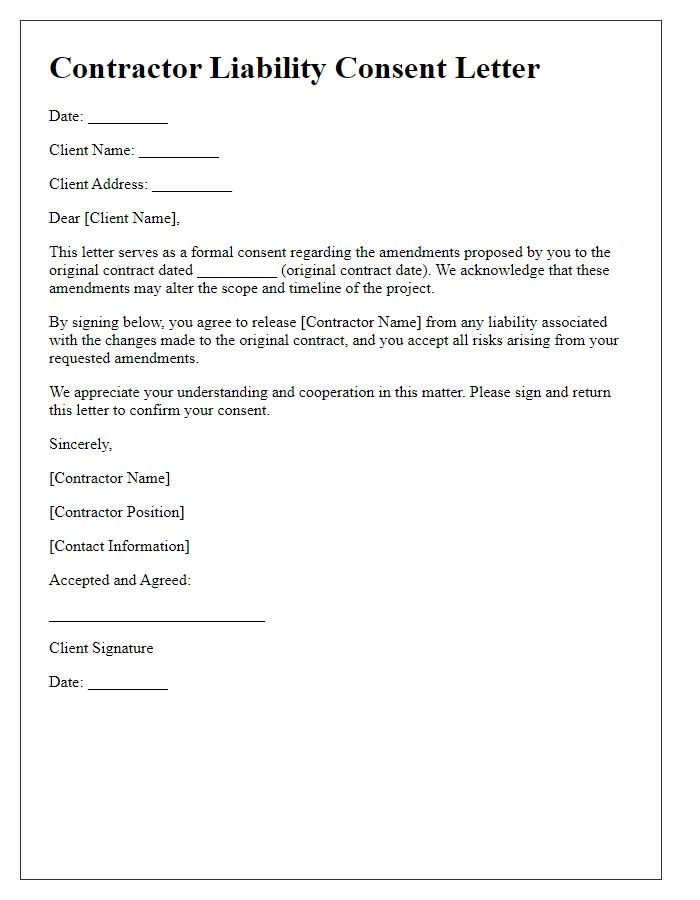Welcome to our guide on contractor liability disclaimers, where we break down what you need to know in straightforward terms. Whether you're a contractor or a homeowner, understanding the ins and outs of liability can save you from potential pitfalls down the line. We'll explore the key components of a solid disclaimer, helping you navigate the complexities of responsibility in construction projects. So sit back, grab a cup of coffee, and let's dive deeper into this essential topic!

Clear Liability Limitation Statement
Contractor liability disclaimers serve to outline the extent to which a contractor is responsible for issues arising during or after a project. These disclaimers often highlight that contractors are not liable for indirect, incidental, or consequential damages resulting from their work. The limitation might include financial caps based on the contract value or specific conditions under which liability applies. It is common for disclaimers to emphasize that issues such as delays, product defects, or project failures are not the responsibility of the contractor if they arise from external factors like natural disasters (hurricanes, floods) or client-provided materials (blueprints, fixtures). In contractual agreements, a clear liability limitation statement articulates these points effectively to protect the contractor's interests while ensuring clients are aware of their responsibilities.
Indemnification Clause
Contractor liability disclaimers, particularly indemnification clauses, are essential in mitigating risks associated with construction projects. These clauses outline the obligations of the contractor, typically a business entity responsible for carrying out work under specific agreements, to protect the client from financial loss due to claims arising from accidents, damages, or legal disputes related to the contractor's work. In such clauses, the contractor may agree to indemnify (compensate) the client for liabilities resulting from negligent actions, including property damage or personal injury, in compliance with applicable laws and regulations. Precise language detailing the scope of indemnity, limitations, and legal jurisdiction, often associated with specific locations like California or Texas, contributes significantly to the enforceability of these agreements. Properly crafted indemnification clauses bolster trust between parties involved and ensure accountability throughout the project lifecycle.
Scope of Work Description
Contractor liability disclaimers play a critical role in clearly defining the boundaries of responsibility between contractors and clients. In a typical construction project, the scope of work includes a detailed description of tasks, timelines, and materials involved. The disclaimer should specify that the contractor is not liable for unforeseen circumstances such as natural disasters, changes in project specifications, or delays caused by third parties. Furthermore, the disclaimer should outline the limits of liability related to damages arising from negligence or failure to meet stated timelines. These measures protect the contractor while ensuring transparency with the client regarding the project's parameters and limitations.
Dispute Resolution Process
Contractor liability disclaimers, particularly regarding the dispute resolution process, often stipulate the steps for addressing conflicts arising from project performance. For instance, the initial step involves a preliminary negotiation stage between the contractor and the client, usually established within a 30-day period after notification of a dispute. Furthermore, if negotiations fail, the parties may elect to pursue mediation, facilitated by a neutral third party, which could take place in locations such as Atlanta, Georgia, known for its arbitration centers. Should mediation be unsuccessful, arbitration may be pursued, following guidelines set by organizations like the American Arbitration Association, with binding decisions made by an arbitrator specializing in construction law. It is crucial to ensure that all communications regarding disputes are documented and adhere to the specified timelines detailed in the contract to protect the rights of each party involved.
Acknowledgment and Acceptance Signature Line
Contractor liability disclaimers are essential for defining the responsibilities and limitations of services provided by contractors. Acknowledgment and acceptance of such disclaimers typically include a signature line for parties involved, which signifies understanding and agreement to the terms within. By signing, contractors and clients recognize risks associated with the project, such as construction accidents, property damage, or service delays, and agree to hold each other harmless. This legal acknowledgment helps prevent potential disputes, ensuring both parties are aware of their obligations and rights throughout the contracting process. Effective disclaimers can enhance trust, paving the way for smoother project execution.
Letter Template For Contractor Liability Disclaimer Samples
Letter template of contractor liability discharge for limited scope work.

Letter template of contractor liability exemption for unforeseen circumstances.

Letter template of contractor liability release for subcontractor agreements.

Letter template of contractor liability limitation for service contracts.

Letter template of contractor liability acknowledgment for non-conformance.

Letter template of contractor liability statement for insurance coverage.








Comments